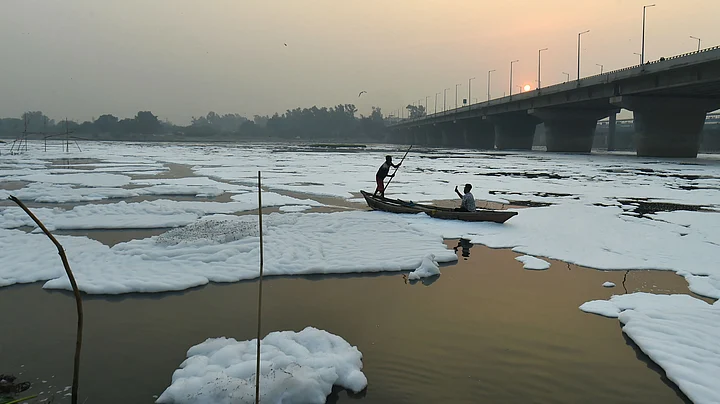A thick layer of white foam floating over the Yamuna river and Chhath Puja devotees standing waist-deep amid toxic froth and offering their prayers – this same image every year in Delhi has now become a 'normalised' annual event.
As political parties take a dig at each other over the frothing of river – almost nothing has changed in the 22-km stretch of Yamuna, flowing from Wazirabad and Okhla.
What causes this foam formation? Why does it specifically happen during this time of the year? And does sprinkling water help? Here's all you need to know.
What is froth formation?
Remember how shaking soapy water causes air to be trapped in it, thus forming small layer of bubbles? This is the science behind froth formation on Yamuna as well.
Under normal circumstances, all rivers form a thin layer of foam. Rivers have dead and decaying plants like leaves and twigs as a part of their ecosystem. On decomposition, these may not may not just dissolve in water but break the surface tension in water – allowing air to enter and create bubbles. This in turn leads to a thin layer of foam – which is natural.
But all foam and froth is not natural.
What causes this harmful foam?
The foam on Yamuna river is anything but natural. According to experts, high level of phosphates in the Yamuna from untreated effluents like sewage, is the main reason for this frothing.
This must happen all year. Why does it specifically froth during October-November every year?
Sushmita Sengupta, Senior Programme Manager of the Water Programme at the Centre for Science and Environment (CSE), speaking to The Indian Express, explained that surfactants and phosphates are a part of detergents used in households and industries.
They make their way to Yamuna all through the year, most of them untreated to remove toxicity – but in winter months, Sengupta explained, that water flow in the river is less.
This means that the pollutants are not diluted but end up forming thick, toxic foam.
Does sprinkling of water really help?
No, not at all. The level of phosphates has to be kept in control – and the river should generally be kept clean for it to exist as an ecosystem.
A healthy river cleans itself with water diluting the presence of phosphates. But that is not the case with Yamuna.
According to The Indian Express, the Delhi Pollution Control Committee banned the sale, storage of soaps and detergents not adhering to the quality standards set by the Bureau of Indian Standards (BIS). The was based on recommendation by now disbanded Yamuna Monitoring Committee.
Not just this, report by YMC also noted that while the BIS standards have improved, there was no way to check if such standard will actually be enforced.
How harmful is this foam?
When presence of phosphates continue in the water – it leads to the growth of algae. This in turn, along with heavy froth, cuts off oxygen and sunlight from mixing with the water body.
This ends up killing off marine life that is essential to maintain the quality of water in Yamuna. While no specific study has been done to ascertain the impact of the froth on human health, doctors warn that it could cause skin irritation if one comes in direct contact.
However, the long-term effects are yet to be studied.
Who is responsible for keeping Yamuna clean in the area it foams?
The Delhi Jal Board – which comes under the Delhi government – has been stating that the location of frothing suggests that it does not come under DJP's purview.
For now, the froth is only seen near Kalindi Kunj, which is downstream of the Okhla barrage. Speaking to The Indian Express, a senior official said that "if the sewage from Delhi was to blame, the frothing would have been seen across the entire stretch of the river."
AAP MP Raghav Chadha, who is also vice-chairman of DJB, in a press conference on 8 November, said the Okhla barrage is maintained by the Irrigation Department of the Uttar Pradesh government.
“It must be that the load of pollutants is high at that point near Okhla, which is why we see the foam at that point,” Sengupta told the newspaper, adding that multiple stretches of the river are likely to be polluted.
(With inputs from The Indian Express)
